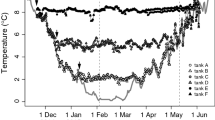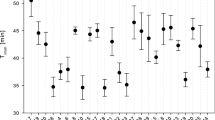Abstract
Life-history responses to two concentrations of fish released info-chemicals at two temperature and food regimes were investigated for one clone of Daphnia hyalina × galeata. The presence of fish kairomones had a negative impact on size at maturity, carbon allocation to individual eggs and size of neonates in all treatments. Food concentration and temperature had positive effects on size of adult stages, independent of kairomone treatment. However, kairomone treatment were not found to interact with food or temperature. Age at maturity was positively influenced by increased temperature and food concentrations, whereas no direct kairomone effects were detected for this trait. Clutch size was not directly influenced by kairomone treatment, whereas both food concentration and temperature had strong, positive effects.
Similar content being viewed by others
References
Boersma, M., P. Spaak, & L. De Meester, 1998. Predator-mediated plasticity in morphology, life history and behaviour of Daphnia: the uncoupling of responces. Am. Nat. 152: 237–248.
Brett, M. T., 1992. Chaoborus and fish-mediated influences on Daphnia longispina population structure, dynamics and life history strategies. Oecologia 89: 69–77.
Davidowicz, P. & C. Loose, 1992. Metabolic costs during predatorinduced diel vertical migration of Daphnia. Limnol. Oceanogr. 37: 1589–1595.
Ebert, D., 1991. The effect of size at birth, maturation threshold and genetic differences on the life-history of Daphnia magna. Oecologia 86: 243–250.
Glazier, D., 1992. Effects of food, genotype and maternal size and age on offspring investment in Daphnia magna. Ecology 73: 910–926.
Gliwicz, Z. M. & C. Guisande, 1992. Family planning in Daphnia - resistance to starvation in offspring born to mothers grown at different food levels. Oecologia 91: 463–467.
Guisande, C. & Z. M. Gliwicz, 1992. Egg size and clutch size in two Daphnia species grown at different food levels. J. Plankton Res. 14: 997–1007.
Hanazato, T. & M. Yasuno, 1989. Zooplankton community structure driven by vertebrate and invertebrate predators. Oecologia 81: 450–458.
Larsson, P. & S. I. Dodson, 1993. Invited review - chemical communication in planktonic animals. Arch. Hydrobiol. 129: 129–155.
Lynch, M., 1980. The evolution of cladoceran life histories. Quart. Rev. Biol. 55: 23–42.
Macháček, J., 1991. Indirect effect of planktivorous fish on the growth and reproduction of Daphnia galeata. Hydrobiologia 225: 193–197.
Reede, T., 1995. Life-history shifts in response to different levels of fish kairomones in Daphnia. J. Plankton Res. 17: 1661–1667.
Reede, T., 1997. Effects of neonate size and food concentration on the life history responses of a clone of the hybrid Daphnia galeata х hyalina to fish kairomones. Freshwat. Biol. 37: 389–396.
Sakwińska, O., 1998. Plasticity of Daphnia magna life history traits in response to temperature and information about a predator. Freshwat. Biol. 39: 681–687.
Salonen, K., 1979. A versatile method for the rapid and accurate determination of carbon by high temperature combustion. Limnol. Oceanogr. 24: 177–183.
Smith, C. C. & S. D. Fretwell, 1974. The optimal balance between size and number of offspring. Am. Nat. 108: 499–506.
Stibor, H., 1992. Predator induced life-history shifts in a freshwater cladoceran. Oecologia 92: 162–165.
Taylor, B. E. & W. Gabriel, 1992. To grow or not to grow: optimal resource allocation for Daphnia. Am. Nat. 139: 248–266.
Tessier, A. J. & N. L. Consolatti, 1989. Variation in offspring size in Daphnia and consequences for individual fitness. Oikos 56: 269–276.
Tessier, A, J. & C. E. Goulden, 1982. Estimating food limitation in cladoceran populations. Limnol. Oceanogr. 27: 707–717.
Threlkeld, S. T., 1979. Estimating cladoceran birth rates: the importance of egg mortality and the egg age distribution. Limnol. Oceanogr. 24: 601–612.
Trubetskova, I. & W. Lampert, 1995. Egg size and egg mass of Daphnia magna: response to food availability. Hydrobiologia 307: 139–145.
Weider, L. J. & J. Pijanowska, 1993. Plasticity of Daphnia life histories in response to chemical cues from predators. Oikos 67: 385–392.
Author information
Authors and Affiliations
Rights and permissions
About this article
Cite this article
Doksæter, A., Vijverberg, J. The effects of food and temperature regimes on life-history responses to fish kairomones in Daphnia hyalina × galeata*. Hydrobiologia 442, 207–214 (2001). https://doi.org/10.1023/A:1017537012727
Issue Date:
DOI: https://doi.org/10.1023/A:1017537012727




